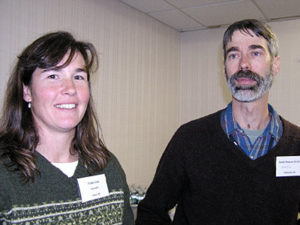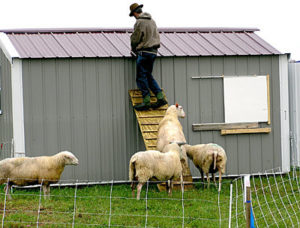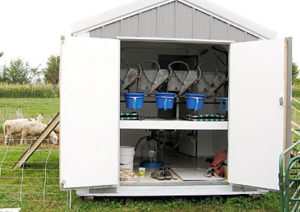 |
| Perry Ells and Keith Morgan-Davie talked about the potential for micro-dairies in Maine, focusing on sheep and goat milk, at the Farmer to Farmer Conference. English photo. |
| Scroll down for: Dairy Goat Budgets & Dairying Resources |
Sheep farmers Keith Morgan-Davie of North Whitefield and Perry Ells of Union described their operations at the Farmer to Farmer Conference in Bar Harbor last November and discussed the Maine Micro Dairy Cooperative.
A Part-Time, Six-Month Enterprise
Ells, a graduate of the University of Vermont, worked on a Suffolk ewe farm in Idaho; grew row crops and greenhouse crops; then worked on a rare breed farm for five years while she built her own farm, starting in 1994 with five sheep. She is enthusiastic about the potential for raising sheep and selling their milk—despite the fact that only 0.4% of the milk consumed in North and Central America comes from sheep or goats. In Turkey, 33% of the milk consumed comes from sheep or goats; in Greece, 58%. “It’s just new where we are,” said Ells, but the Mediterranean and Africa, the potential for sheep “is a no-brainer” – the lack of forage there makes sheep and goats a better fit for the land than cows. So, even though one cow (depending on the breed) may produce as much milk as 60 sheep in the first lactation, the foraging nature of sheep and the growing market for their milk are pluses. (Goats produce two to three times as much milk as sheep.)
Ells tends her 70 ewes herself (or sometimes with a half-time summer apprentice, sharing a full apprenticeship with Appleton Creamery, which makes cheese from Ells’ sheep’s milk). She shears at the end of January; starts lambing in February; and soon after starts milking. Her meat market kicks in just as dairying declines, and her busy, six-month season ends just as her children start their busy season of soccer, etc. She notes that farmers could run another enterprise for the next six months.
For a 50-ewe flock, Ells calculated a first-year gross income of $19,125 and a net of $7,425 from finished lamb, wool and milk sold to a local cheese maker. The net would increase as the genetics of the herd improved; and it would be better for goats, which can be milked longer and produce more. Ells’ sheep now produce twice what they did in her first year of operation, and 15 to 20 of her ewes produce 400 pounds per lactation – the most one can get in the United States.
Moving her sheep, milking, cleaning up and getting them back out, twice a day, takes about 4 ½ hours daily. Milking once a day would halve the time. Another option is to milk once a day for the first 45 days, while the lambs continue to nurse, then weaning and milking twice a day after about the 15th of July.
Pilot-Farmer Turns to Cooperative Work
Morgan-Davie was an airline pilot for 14 years, a career that helped build his former Windhaven Farm in upstate New York. Like Ells, he started small – with six Dorset ewes – then increased to 55 to 65. He made yogurt and cheese and sold them from the farm and to health food stores. He also raised pastured poultry; he bought 400-pound stocker calves in April and raised them on pasture, moving them every 24 hours, until they reached 1,100 to 1,200 pounds by late October or early November, when they were butchered; he sold eggs; and raised a dozen pigs. Last spring, because of burnout and for personal reasons, he sold the farm and moved to Maine.
At Windhaven, Morgan-Davie bred his Dorsets with an East Freesian ram. “The first generation cross doubles milk production of the dam in the first year, on average,” he explained. “This is a really cost-effective way to start out. Rams are expensive ($1,000 to $1,500),” but commercial ewes cost much less.
Why Sheep’s Milk?
Sheep’s milk has high levels of fat and casein protein, which is good for making cheese. Farmers can promote the greater nutrient value of sheep’s milk (although the value differs among breeds), and they can meet the needs of lactose-intolerant consumers, said Ells.
Morgan-Davie noted that much of the intolerance to cow’s milk is from the A1 casein molecule, which is common in cows (especially Holsteins; it’s somewhat less in Jerseys and some Island cattle). Sheep’s milk, however, is higher in A2 casein; intolerance to this protein is rare. A link may exist between some childhood autism and the A1 protein. One of his customers, whose 8-year-old son had not gained weight in two years because of intolerance to all proteins he had tried, gained weight within two weeks of consuming Morgan-Davie’s sheep’s-milk yogurt. “There’s a whole emerging market” for such individuals, he said. Ells added that in Great Britain, sheep’s milk is one of the fastest growing markets.
In 1998, the United States imported the most sheep’s milk of 18 reporting countries, and we imported 2.5 times as much as the next highest country. In addition to health benefits, the milk is used in such cheeses as feta, halloumi, pecorino Romano, Roquefort, kash raval, some ricotta and others.
Virtual Farm Tour
Morgan-Davie showed photos of Windhaven, noting that an existing horse barn with posts was not suitable for sheep, who “want to go everywhere in a big clump.” Lambs can be killed if pushed against the posts. So he built a free span, 52′ x 45′ barn, in which temporary panels separated groups of sheep as needed. Most of the time his sheep were outside, pasture-based. They were fed hay in winter – outside – and had free access to indoors and out. “If they want to eat, they have to go out.” Part of the barn was divided into three 10- x 14-foot rooms for a milking parlor, milk house and creamery.
Sheep don’t drink much water in the winter, said Morgan-Davie; instead, they eat snow. He had a heated waterer, but his animals rarely used it.
One advantage sheep have over goats is their 4-inch wool blanket; thus they prefer to be outside even in cold or wet weather.
Morgan-Davie had anticipated milking about 100 ewes, but downsized to the 65 or so that he could milk seasonally on his own. His ewes lambed between the end of April and mid-May. He didn’t milk them for the first few days after lambing, so that the colostrum, which doesn’t make good cheese anyhow, would be used by the lambs, for whom it’s critical. If a ewe had a single lamb, he’d wait four or five days before milking so that the lamb had a chance to get all the colostrum.
He started milking around April 24 or 25 and was done by October 1; some people milk for six months. Although he milked seasonally, he processed year-round, using frozen milk. (Ells’ sheep start lambing in February or March in order to have finished lamb in June for tourists. Ells mentioned a woman who gets so much milk from her goats – 6 to 8 quarts early in the lactation – that she can milk the animals and still let the young nurse. “Sheep, by comparison, produce about 1 quart per day.”)
Management Options
Morgan-Davie said that sheep can be hard-weaned at 30 days or 30 pounds after being with their mothers all the time before that; or, once the colostrum clears, farmers can separate lambs from ewes at 6, 7 or 8 p.m., milk in the morning, then reunite lambs with ewes (or kids with does). He knows one sheep farmer who milked once a day and never weaned the lambs, because this schedule fit his lifestyle. Farmers do have to watch for health problems if they leave the young with the mothers for long: The mothers have some immunity to health problems but may pass problems to their young, who lack immunity.
To time milk production with grass availability, Ells suggested scheduling lambing as Morgan-Davie did and putting adults and young out together – but this would require a good rotational grazing system and deworming. In Ells’ system, by the time the grass is ready, lambs have long been separated from ewes, and lambs precede ewes on the best pasture.
Ells feeds her sheep hay and grain in winter, based on body condition. A ewe that had a single lamb tends to be overweight and won’t need as much feed as one who had twins and is in great condition. A ewe that had triplets or quads and is still recovering needs extra feed – especially since she’s likely to produce triplets or quads again. Ells keeps her sheep in two pens during lambing, and replacements get their own pen because they get more grain.
Ells breeds ewes their first year. “Freesians line up especially, when they’re seven months old, and back the ram into the side of the barn. Dorsets play this whole ‘Don’t touch me’ thing.”
At first, Morgan-Davie bred ewes that weighted 110 pounds by Dec. 1, but found that those bred at 110 pounds never made their potential weight in his very low-input system – despite having plenty of quality pasture (peaking at around 32% protein). He believes the smaller body had a smaller rumen, so the animal couldn’t eat so much, so it produced less milk. “I lost about 15% of milk production.”
So he started breeding yearlings, and average milk production went up enough to make the wait worthwhile. “If you have a different feeding regime, the results will vary,” he said, adding that farmers have to watch carefully that calcium is not depleted in ewes’ bones. He fed some of his animals, depending on their condition, a small amount of grain (barley, wheat or triticale mixed with about 25% whole corn) for energy during the last third of gestation. “I would also feed a little grain for flushing just before breeding, if necessary,” he added.
In the milking parlor, ewes get just enough grain to encourage them to put their heads down and walk into the milking stand.
In working with livestock, Morgan-Davie said to make the animals go in the desired direction with gates that close and give the animals no choice but to go up a ramp, for instance. Unless they’re frightened, livestock tend to go in the direction they’re moving. The entrance to his milking parlor had a guillotine-style door rather than one that closes from the side, since sheep don’t tend to see overhead. Once the sheep were in the parlor, the door was easily shut to keep them in.
Morgan-Davie milked into two 4-gallon buckets and pasteurized milk in a custom-built, $12,500 pasteurizer, which was less expensive than a pre-built one. New York state is very touchy about raw milk products; he finds Maine more reasonable.
Ells noted that in Maine, cheese that’s more than 60 days old doesn’t require pasteurized milk, so this is one way to avoid spending about $10,000. Farmers can also sell raw milk products in Maine, after a state inspection of their facilities and a record of very clean milk.
The difference between heat treating and pasteurization is legal, said Morgan-Davie. Both require heating milk to 145 F. for 30 minutes, then cooling it, but pasteurization means the temperature of the milk and the air overhead was recorded throughout the process on a certified thermometer.
The Micro Dairy Cooperative
The goal of the Maine Micro Dairy Cooperative (MMDC) is to increase the supply of quality milk for Maine’s artisan dairy producers and processors by helping people set up systems to produce quality milk. “The classic view in the United States,” said Morgan-Davie, “is that if the milk is not clean enough, make cheese. Our view is that there should not be contaminants.
 |
| The Maine Micro-Dairy Development Cooperative had a presence at the Common Ground Country Fair, featuring Keith Morgan-Davie and some curious sheep. English photo. |
“We’re still surveying farmers to find out their needs.” The MMDC hopes to create new sheep, goat and cow dairies; assist existing dairies; increase the milk supply; and improve its distribution.
One way it can help is through its Mobile Milking Unit (MMU) – a self-contained, small milking parlor and milk room that can handle six sheep or goats at a time – or one cow, Ells believes.
Instead of taking the time and about $25,000 to build and equip a structure, the mobile unit can save months and, at $12,000 (without financing), thousands of dollars. (The unit can also be leased with an option to buy for $13,000; and financing at 2% interest for six years is available.) Savings occur because the unit sits on skids rather than a foundation, and the equipment for the 8′ x 16′ building is scaled down. It’s mobile in that it can be moved onto the property fairly easily, but once the electrical, water and propane are installed, it’s best left in place. It does not require a septic system.
 |
| Inside the micro-dairy. English photo. |
The state-inspected and licensed unit includes a milking parlor, headgates, minimal storage for feed and supplies, hand towel dispenser, trash receptacle, and ramps and gates to control the flow of livestock. The other section contains a grade “A” milk room, including the required two-bay wash sink, hand wash sink, draining racks, towel dispenser, trash receptacle and water heater.
Milk is cooled with an in-can cooling system: A cooling unit is inserted into the full can until the milk is below 45 F. The cooled can is then stored temporarily in the MMU refrigerator, or is moved to another storage area until it’s used or delivered to a processor.
The unit comes with a vacuum pump, water heater, refrigerated storage for a 10-gallon milk can, a stainless steel milk can, an in-can milk cooler, a milking bucket with lid, a pulsator, two goat or sheep milking clusters with hoses, cleaning brushes, teat dip and dip-cup, cleaning and sanitizing supplies, towels, etc. (See www.mainemicrodairy.org.)
This seasonal unit could be used year-round with insulation and a small heater, but sheep are seasonal milkers.
Systems for Dairying
Morgan-Davie said that hand milking is great with a few animals; bucket milking is the next step (where the MMU fits); and a pipeline pumping milk to a bulk tank fits operations with some 200 sheep or more.
A milking parlor with a raised platform is useful with sheep and goats, which climb easily; it saves farmers’ knees. A pit parlor, with the farmer below the ground-level animals, works with cows.
Fluid milk can be held for only 48 hours, legally, before it has to be moved out of bulk tanks and used. It must be cooled to less than 45 F. within two hours by law, but getting it to 35 F. in that time provides a longer shelf life.
After it’s cooled, sheep’s milk can be frozen for later use and easier shipment (since it won’t spill), helping with cash flow. Morgan-Davie froze most of his ewes’ milk and produced cheese and yogurt over 12 months. Sheep’s milk is the only milk that freezes and thaws reliably; other types separate and the proteins shatter more easily. Morgan-Davie put 6,000 pounds of milk, in plastic bags, in a 6- x 8-foot walk-in freezer that force cooled the product so that it froze quickly and deeply at -15 degrees F. A home chest freezer will not freeze milk deeply enough; suitable freezers are available from used restaurant equipment dealers; they may cost about $100/month to run, depending on the cost of electricity. A backup generator is recommended.
To manage sheep, the flock can be confined, which is “not necessarily a bad word,” said Morgan-Davie. “It just means there is not enough pasture available for a pasture-based system. The sheep should be comfortable, dry and have enough room to move around.” Grazing means you open a gate and the sheep graze where they want. Management Intensive Grazing (moving animals frequently to smaller, fenced pasture) makes grass most of an animal’s diet and can at least double the land’s productivity.
Culling problem animals can build a herd that needs to be checked only at night and in the morning.
Adding value to sheep’s milk can add income to a farm, but dairying, processing and having a family are each full-time jobs; it’s easy to burn out.
Getting Started
Diane Schivera, MOFGA’s organic livestock specialist, recommended consulting the Maine Department of Agriculture before you start dairying. “They’ll tell you what you need.” Glendon Meheuren of Faithful Venture Farm in Montville also does consulting, and Morgan-Davie can help with licensing and other preliminary consulting as part of his grant-funded job. When buying used equipment (see resources), have someone check it first for hidden problems. The state will check your equipment once a year, free.
– Jean English
Readers who would like to know more about Ells Farm or who have questions pertaining to sheep dairying may contact Perry Ells at [email protected].
